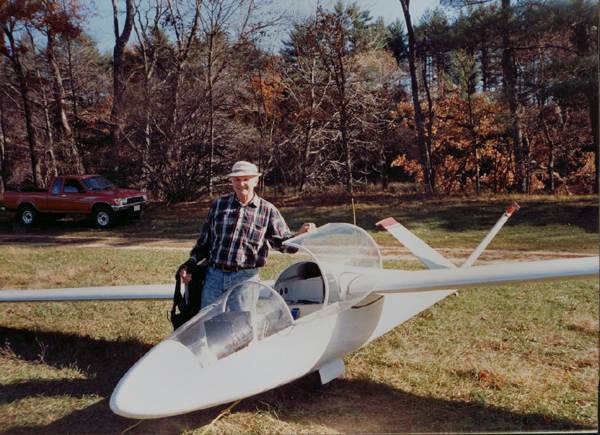I am a long-time mechanical engineer, and at 79 not even thinking of retirement. In 1939 my father, who had known SSA founder Warren Eaton, took my older brother and me to a Labor Day week event in Elmira, the last meet before WWII. It was all exciting and eye-opening for a 12-year old boy. My strongest memories are of looking upwards at a fabric-covered wing filled with slender wooden traceries, sunlight shining through (this was before the days of aluminum primer paint), and the story of a long contest flight from Elmira to New Jersey. There was also an instance of a landout and tiedown, with the removal of the horizontal stabilizer for safety. Naturally, some vandal stole the stabilizer for a souvenir and put the poor guy out of the race.
The Baby Bowlus was then available in kit form, and we two boys pushed hard on Dad to build it. A month after returning home a package arrived labeled "glider cover" which surprised us, since we supposed the cover would be the last thing to put on the glider, not the first. It turned out to be a fitted fabric cover for our porch glider. Aw, nuts!
My own soaring started after my first wife's death ten years ago, and I flew for a year with the Greater Boston Soaring Club in Pepperell, MA and got my private license. (I have about 800 hours in power, none current.) I found the HP-14 in Kansas and a traveling friend towed it back for me.

My HP-14 is serial 44, begun by a dentist and an airline pilot, and finished by the shop of the flying school of Central Missouri State University. It was used by the flying students only 25 hours before a ground accident tore up the tail cone. The school sold it at auction to a spray pilot in Greenberg, KA, who replaced the sheet metal and signed it off. He never flew it. The University wanted to keep the original registration of N106CM, and it is now N102MW.
I spent the first summer cleaning and straightening things up, built a new flap drive, blew the wasps out of the instrument tubing, and so on. I finally flew it in November before the season closed, and on the third flight the canopy flew open (one of the four pins that lock the canopy frame was not in its hole). Open Canopy In Flight has many stories; all ran instantly through my mind as I reached up to fight the canopy closed. That proved to be no problem since the Plexi was gone forever, and I landed without incident except for it being pretty breezy and embarrassing. One of the winter's tasks was to build a new hinge/latch system which is absolutely secure and reliable and allows for simple canopy removal.
I removed the hydraulic pump/cylinder flap drive and built a straight run handle and pushrod, with a bell crank to the flap torque tube. I have reinforced the inserted steel triangle in the flap inner end, with a more generous insertion guide for the torque tube. I also removed the torque tube end pivots and put a single pivot next to the torque tube bell crank. This removes any cramping of pivot pins caused by misalignment of flap hinges and pivot pins.
The long lift pins on the wing spar were replaced with a single pointed lift pin on each side for easier wing assembly. Alignment of the spar clevises has been improved by adding guide blocks, but it still takes three people to place the wings. Fortunately I can fabricate sheet metal, since I have made two wheel-up landings. Man, that glider stops fast.
I built up the fuselage sides under the wing with a permanent fillet, and extended the turtle-deck with a permanent fillet so I have only to add white vinyl tape to seal neatly. The turtle-deck also carries a permanent head rest.
I find I can get off the ground easier with 10 degrees of flap, and then slowly bring up the flap as the tow plane leaves the ground. Cross control lets me stay level and follow the tow plane. I have not been using negative flaps for flying.
I am concerned with landouts and small cow pastures, so my approaches are about 200 feet higher than usual. I must slow down to 45 MPH before I can pull full flaps. I rotate to about 60 degrees nose down, and we just grind down like a steep escalator, the wings rumbling and humming. I believe in this condition it is impossible to stall even with a tailwind gust. It is very smooth and controlled, and I flare easily at the last moment with full flaps. I suppose my descent line is closer to 45 degrees than 60 since the wing is lifting strongly all the way down. It does make an impressive short landing.
Our club has moved to Sterling MA, and with a merger with MIT Soaring Club we have 165 members now, almost uncomfortably large. A few years ago we had two HP-14 sailplanes.
I'm looking forward to contact with others who share my appreciation of the works of Dick Schreder.